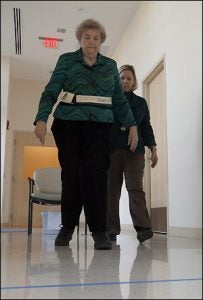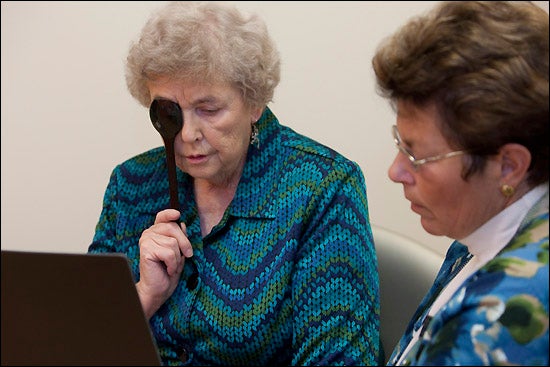Steady on their feet
ECU team assesses older adults' risk of falling
Marjorie Franck can line dance again, a goal she set during rehabilitation after five falls in one year and a hip replacement.
Her comeback began after she was evaluated by a health care team at East Carolina University’s Fall Risk Assessment Clinic in the Frances J. and Robert T. Monk Sr. Geriatric Center. A physical therapist, occupational therapist, pharmacist, social worker, nurse and physician evaluate patients 60 and older for their risk of falls – all during one appointment – and give personalized recommendations to avoid falls.
Falls are the leading cause of injury-related accidental death in older adults. The problem is multi-faceted and crosses many disciplines in the care of older patients. “Here at ECU, we can bring all those disciplines together,” said Dr. Kenneth Steinweg, chairman of family medicine at ECU who evaluates patients in the fall risk clinic.
Screening tests are done for medical conditions, medications, health habits, daily life skills, home safety hazards, vision, cognition, mood, balance, dizziness, foot sensation, leg strength, walking, shoes and walking aids.
“I feel the falls clinic is wonderful,” said Franck, 75, a retired tax preparer who lives in Greenville. “They gave me my life back. I feel like I’ve come a long way.”

Marjorie Everett completes a timed walking test with ECU assistant professor and physical therapist Dr. Leslie Allison.
Franck received a written summary of her evaluation and steps to prevent future falls. The clinic collaborates with patients’ primary care physicians, who receive a copy of the report. For three months, a social work intern calls once a week to see how each patient is doing and if they are having trouble implementing recommendations.
“I started with a walker, and in June I graduated to not using the walker,” Franck said. “The walker is packed up.”
On a recent weekday, she walked one mile, something she tries to do three to five times each week.
“When I was falling, I was either breaking something or getting stitches,” said Franck, pointing above her eye where she once received 16 stitches. One of those falls was down the back steps of her home. But she has followed the fall clinic’s recommendations for prevention.
“We put in a railing,” she said. “I always have one hand free, and I never, never, never go down the steps without one hand free.”
Statistics show that one-third of people 65 and older and nearly half of people 85 and older fall at least once a year. Without intervention, half of those will fall repeatedly. An estimated 15 percent to 20 percent of falls lead to injury, and 5 percent result in a hip fracture.
Facts about falling
- Falling is not a normal part of aging.
- Falls are the leading cause of doctor and emergency room visits, hospital and nursing home admissions, and accidental death in people 65 and older.
- One in three older adults in the United States falls at least once per year, and half fall repeatedly.
- The cost of fall injuries for older adults totaled $19 billion in 2000.
- In addition to ECU’s fall risk assessment clinic, community programs to help reduce falls are available including Matter of Balance, SPICE for Life, and senior exercise programs at the Pitt County Community Schools and Recreation Center and ViQuest.
“Either you help yourself, or you sit yourself in a chair. I’m not ready to do that,” Franck said.
Neither is Marjorie Everett, a retired Pitt County public health nurse who visited the clinic for the first time Nov. 2. Her geriatrician referred her after falling four times in the past year.
She has already taken steps to reduce her risk of falls, including installing a railing at her door and replacing slippery rugs in her home. She said she has been impressed with the falls clinic and the range of specialists that worked together during her evaluation.
“I want to do what I need to do to stay vertical,” said Everett, 80. “If I can stay vertical, I’ve got it made.”
Falls are not a normal part of growing older, but certain chronic health conditions such as stroke or Parkinson’s disease combined with medication side effects can decrease balance and increase the risk of falls in older adults.
The team uses evidence-based medicine in making patient recommendations, said Jane Painter, professor of occupational therapy in the ECU College of Allied Health Sciences which partners with the Brody School of Medicine in offering the clinic each Wednesday afternoon.
A reduction in falls and fall risk can occur with proper diagnosis and education including behavior change, adoption and adherence to exercise and physical activity, home modifications and good judgment.
“We’re trying to identify fall risk early so that remediation can take place so future falls don’t occur,” Painter said.
Assessments also can help lessen fear of falling, a separate but related problem that can lead to isolation, depression and anxiety, decreased flexibility and a sedentary lifestyle. “Those with high anxiety tend to have a fear of falling whether they’ve fallen or not,” Painter said. “Then the person tends to sit, which makes them weak and more at risk for falling. It’s a vicious cycle.”
The fall clinic started three years ago with a grant from the Pitt Memorial Hospital Foundation. The assessment team includes Painter, Steinweg, physical therapist Leslie Allison, pharmacist Ann Marie Nye and social work intern Brittany Moore.
Call 252-744-2045 for more information or to schedule an appointment.
###
